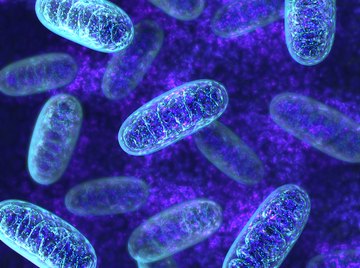
The mitochondrion, an organelle that helps produce energy for the cell, is only found in eukaryotes, organisms with relatively large, complex cells. As such, many cells and single-celled organisms don't have one. Cells with mitochondria contrast with prokaryotes, which lack set, membrane-bound organelles, such as mitochondria. Eukaryotes include everything from one-celled paramecium to plants, fungi, and animals. In short, many cells have mitochondria and many don't, and the difference is important.
TL;DR (Too Long; Didn't Read)
The mitochondrion, sometimes called the "powerhouse of the cell," is common among complex organisms, which use the organelle to convert oxygen into energy. However, there are some single-celled organisms and other cells that lack set organelles that do not have one.
What is a Mitochondrion?
The mitochondrion, the singular of mitochondria, turns oxygen into usable energy in the form of ATP. By allowing organisms to use oxygen, mitochondria supported the evolution of complex organisms. Scientists believe that the mitochondrion actually began as a free-living organism that another cell consumed. Instead of digestion, the larger cell kept the ancestor of mitochondria inside itself, providing food and shelter, while the pre-mitochondria, in turn, gave the host cell the ability to use oxygen. Over time, mitochondria lost their ability to live outside the host cell and vice versa. Scientists call this idea the "endosymbiosis theory."
"Before the Kernel"
Relatively simple organisms like bacteria and members of the archean domain belong to a category of life called the prokaryotes. Prokaryotes lack most of the structures found in eukaryotes, including any membrane-bound organelle. This includes a mitochondrion and a nucleus. The name prokaryote roughly translates to "before the kernel," a name that refers to these organisms' lack of an organized, membrane-bound nucleus. Since bacteria lack mitochondria, the vast majority of them cannot use oxygen as effectively as eukaryotes.
Eukaryotes Without Mitochondria
In contrast to the prokaryotes, eukaryotes have a more complex layout, including membrane-bound organelles like mitochondria. Most eukaryotes have mitochondria, while every multi-cellular eukaryote does. However, a few one-celled eukaryotes lack mitochondria. All of this type of eukaryote live as parasites. Scientists believe that these particular eukaryotes descended from primitive eukaryotes that never had mitochondria, or descended from species that, at one point, had mitochondria, but later lost them. Additionally, some multicellular eukaryotes lack mitochondria in specific cells. For example, human red blood cells lack mitochondria, an adaptation that either reduces the cells' size or prevents them from using the oxygen they carry.
Alternatives and Extras
Several other eukaryotic organelles share important commonalities with mitochondria. Some scientists believe that the chloroplast, a similar organelle, descended from blue-green algae that eventually lost their ability to live outside cells, much like mitochondria. Chloroplasts allow some eukaryotes, like plants and algae, to use sunlight to produce energy and oxygen for their cells, which is then used by their mitochondria. Additionally, the hydrogenosome plays a similar role to the mitochondria, but function in oxygen-poor environments. These were originally known as fungi and one-celled eukaryotes, but have recently been found in very small, simple animals that live in oxygen-poor seafloors.
References
